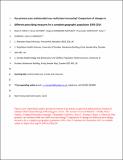Files in this item
Has primary care antimicrobial use really been increasing? Comparison of changes in different prescribing measures for a complete geographic population 1995–2014
Item metadata
| dc.contributor.author | Neilly, Mark D. J. | |
| dc.contributor.author | Guthrie, Bruce | |
| dc.contributor.author | Hernandez Santiago, Virginia | |
| dc.contributor.author | Vadiveloo, Thenmalar | |
| dc.contributor.author | Donnan, Peter T. | |
| dc.contributor.author | Marwick, Charis A. | |
| dc.date.accessioned | 2018-09-30T23:50:45Z | |
| dc.date.available | 2018-09-30T23:50:45Z | |
| dc.date.issued | 2017-10-01 | |
| dc.identifier | 251478994 | |
| dc.identifier | 85d5dd99-2798-4656-ab5b-d4060bab2d95 | |
| dc.identifier | 85030714085 | |
| dc.identifier.citation | Neilly , M D J , Guthrie , B , Hernandez Santiago , V , Vadiveloo , T , Donnan , P T & Marwick , C A 2017 , ' Has primary care antimicrobial use really been increasing? Comparison of changes in different prescribing measures for a complete geographic population 1995–2014 ' , Journal of Antimicrobial Chemotherapy , vol. 72 , no. 10 , pp. 2921-2930 . https://doi.org/10.1093/jac/dkx220 | en |
| dc.identifier.issn | 0305-7453 | |
| dc.identifier.other | RIS: urn:F85DE0C5509EBC095AFCDC0AE7C57CB9 | |
| dc.identifier.other | ORCID: /0000-0002-8544-1483/work/71560031 | |
| dc.identifier.uri | https://hdl.handle.net/10023/16115 | |
| dc.description.abstract | Objectives To elucidate how population trends in total antimicrobials dispensed in the community translate into individual exposure. Methods Retrospective, population-based observational study of all antimicrobial prescribing in a Scottish region in financial years 1995, 2000 and 2005–14. Analysis of temporal changes in all antimicrobials and specific antimicrobials measured in: WHO DDD per 1000 population; prescriptions per 1000 population; proportion of population with ≥1 prescription; mean number of prescriptions per person receiving any; mean DDD per prescription. Results Antimicrobial DDD increased between 1995 and 2014, from 5651 to 6987 per 1000 population [difference 1336 (95% CI 1309–1363)]. Prescriptions per 1000 fell (from 821 to 667, difference –154, –151 to –157), as did the proportion prescribed any antimicrobial [from 39.3% to 30.8% (–8.5, –8.4 to –8.6)]. Rising mean DDD per prescription, from 6.88 in 1995 to 10.47 in 2014 (3.59, 3.55–3.63), drove rising total DDD. In the under-5s, every measure fell over time (68.2% fall in DDD per 1000; 60.7% fall in prescriptions per 1000). Among 5–64 year olds, prescriptions per 1000 were lowest in 2014 but among older people, despite a reduction since 2010, the 2014 rate was still higher than in 2000. Trends in individual antimicrobials provide some explanation for overall trends. Conclusions Rising antimicrobial volumes up to 2011 were mainly due to rising DDD per prescription. Trends in dispensed drug volumes do not readily translate into information on individual exposure, which is more relevant for adverse consequences including emergence of resistance. | |
| dc.format.extent | 10 | |
| dc.format.extent | 1082455 | |
| dc.language.iso | eng | |
| dc.relation.ispartof | Journal of Antimicrobial Chemotherapy | en |
| dc.rights | © 2017, the Author(s). This work has been made available online in accordance with the publisher’s policies. This is the author created, accepted version manuscript following peer review and may differ slightly from the final published version. The final published version of this work is available at https://doi.org/10.1093/jac/dkx220 | en |
| dc.subject | RM Therapeutics. Pharmacology | en |
| dc.subject | 3rd-DAS | en |
| dc.subject.lcc | RM | en |
| dc.title | Has primary care antimicrobial use really been increasing? Comparison of changes in different prescribing measures for a complete geographic population 1995–2014 | en |
| dc.type | Journal article | en |
| dc.contributor.institution | University of St Andrews.School of Medicine | en |
| dc.identifier.doi | 10.1093/jac/dkx220 | |
| dc.description.status | Peer reviewed | en |
| dc.date.embargoedUntil | 2018-10-01 | |
| dc.identifier.url | http://hdl.handle.net/10588/fe45feef-a138-415e-9d19-6096a66acb86 | en |
This item appears in the following Collection(s)
Items in the St Andrews Research Repository are protected by copyright, with all rights reserved, unless otherwise indicated.

